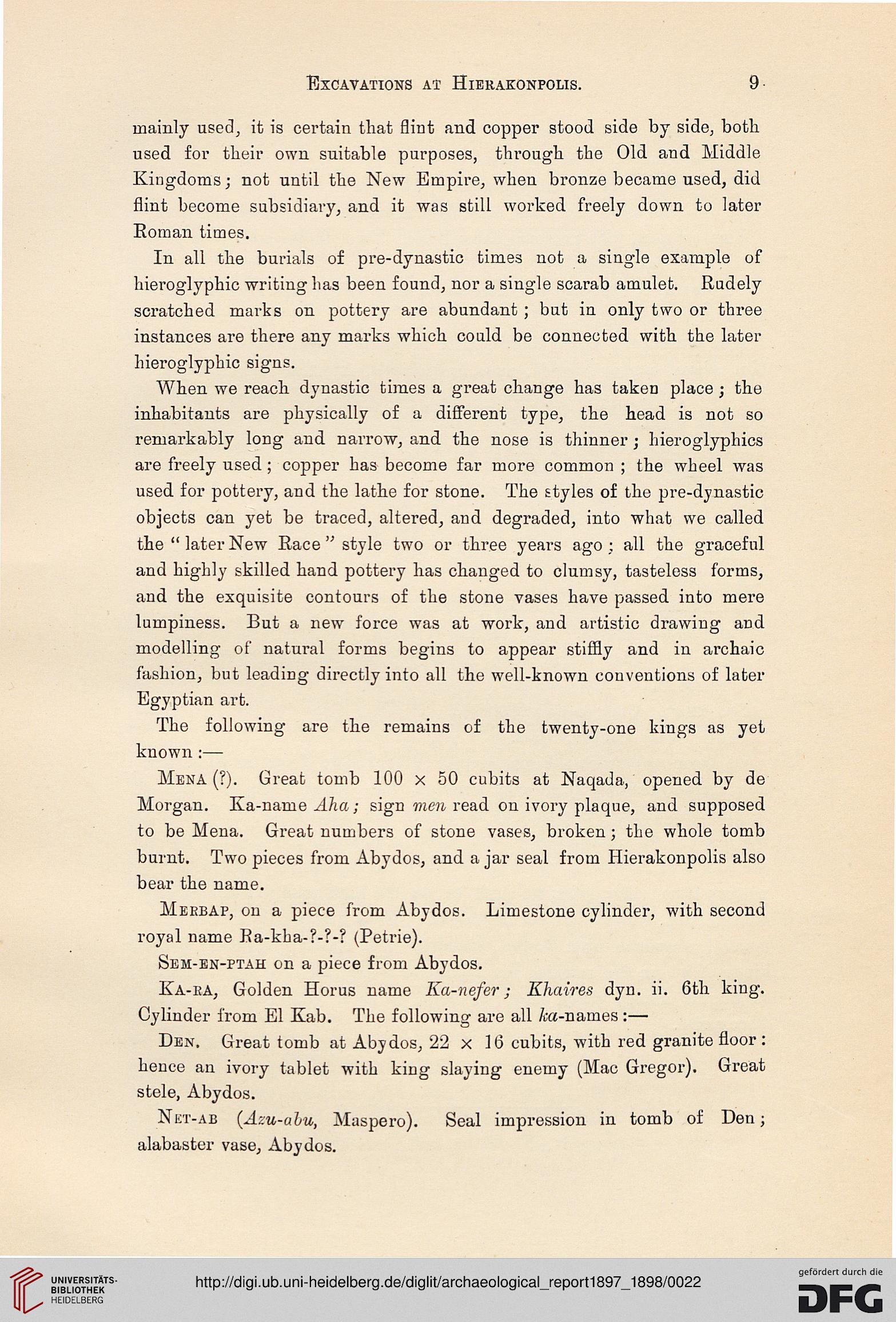Excavations at Hierakonpolis.
9
mainly used, it is certain that flint and copper stood side by side, both
used for their own suitable purposes, through the Old and Middle
Kingdoms; not until the New Empire, when bronze became used, did
flint become subsidiary, and it was still worked freely down to later
Roman times.
In all the burials of pre-dynastic times not a single example of
hieroglyphic writing has been found, nor a single scarab amulet. Rudely
scratched marks on pottery are abundant ; but in only two or three
instances are there any marks which could be connected with the later
hieroglyphic signs.
When we reach dynastic times a great change has taken place ; the
inhabitants are physically of a different type, the head is not so
remarkably long and narrow, and the nose is thinner ; hieroglyphics
are freely used ; copper has become far more common ; the wheel was
used for pottery, and the lathe for stone. The styles of the pre-dynastic
objects can yet be traced, altered, and degraded, into what we called
the " later New Race " style two or three years ago: all the graceful
and highly skilled hand pottery has changed to clumsy, tasteless forms,
and the exquisite contours of the stone vases have passed into mere
lumpiness. But a new force was at work, and artistic drawing and
modelling of natural forms begins to appear stiffly and in archaic
fashion, but leading directly into all the well-known conventions of later
Egyptian art.
The following are the remains of the twenty-one kings as yet
known :—
Mena (?). Great tomb 100 x 50 cubits at Naqada, opened by de
Morgan. Ka-name Aha; sign men read on ivory plaque, and supposed
to be Mena. Great numbers of stone vases, broken; the whole tomb
burnt. Two pieces from Abydos, and a jar seal from Hierakonpolis also
bear the name.
Meebap, on a piece from Abydos. Limestone cylinder, with second
royal name Ra-kha-?-?-? (Petrie).
Sem-en-ptah on a piece from Abydos.
Ka-ea, Golden Horus name Ka-nefer; Khaires dyn. ii. 6th king.
Cylinder from El Kab. The following are all k-uames:—
Den. Great tomb at Abydos, 22 x 16 cubits, with red granite floor:
hence an ivory tablet with king slaying enemy (Mac Gregor). Great
stele, Abydos.
Net-ab (Azu-abu, Maspero). Seal impression in tomb of Den;
alabaster vase, Abydos.
9
mainly used, it is certain that flint and copper stood side by side, both
used for their own suitable purposes, through the Old and Middle
Kingdoms; not until the New Empire, when bronze became used, did
flint become subsidiary, and it was still worked freely down to later
Roman times.
In all the burials of pre-dynastic times not a single example of
hieroglyphic writing has been found, nor a single scarab amulet. Rudely
scratched marks on pottery are abundant ; but in only two or three
instances are there any marks which could be connected with the later
hieroglyphic signs.
When we reach dynastic times a great change has taken place ; the
inhabitants are physically of a different type, the head is not so
remarkably long and narrow, and the nose is thinner ; hieroglyphics
are freely used ; copper has become far more common ; the wheel was
used for pottery, and the lathe for stone. The styles of the pre-dynastic
objects can yet be traced, altered, and degraded, into what we called
the " later New Race " style two or three years ago: all the graceful
and highly skilled hand pottery has changed to clumsy, tasteless forms,
and the exquisite contours of the stone vases have passed into mere
lumpiness. But a new force was at work, and artistic drawing and
modelling of natural forms begins to appear stiffly and in archaic
fashion, but leading directly into all the well-known conventions of later
Egyptian art.
The following are the remains of the twenty-one kings as yet
known :—
Mena (?). Great tomb 100 x 50 cubits at Naqada, opened by de
Morgan. Ka-name Aha; sign men read on ivory plaque, and supposed
to be Mena. Great numbers of stone vases, broken; the whole tomb
burnt. Two pieces from Abydos, and a jar seal from Hierakonpolis also
bear the name.
Meebap, on a piece from Abydos. Limestone cylinder, with second
royal name Ra-kha-?-?-? (Petrie).
Sem-en-ptah on a piece from Abydos.
Ka-ea, Golden Horus name Ka-nefer; Khaires dyn. ii. 6th king.
Cylinder from El Kab. The following are all k-uames:—
Den. Great tomb at Abydos, 22 x 16 cubits, with red granite floor:
hence an ivory tablet with king slaying enemy (Mac Gregor). Great
stele, Abydos.
Net-ab (Azu-abu, Maspero). Seal impression in tomb of Den;
alabaster vase, Abydos.





